Activities in 2014
1. Prior to Departure
| ■ Workshop: Imagine a World without Nuclear Weapons | 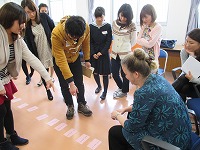 |
| Kathleen Sullivan, who specializes in nuclear disarmament education, from New York, and Steven Leeper, former director of the Hiroshima Peace Culture Foundation, led a 3-day workshop that includes discussions and fieldwork. | |
| ■ Five Interconnected Lectures: Learning about Nagasaki | |
| Traveling lecturers from Peace Baton Nagasaki who teach peace, came to teach these five interconnected classes. Participants learned about the facts and background of the Nagasaki Atomic Bombing and also took a “Saruku”— meaning “strolling leisurely about town” in the local dialect – to see remains from the bombing. | |
| ■ Seven Interconnected Study Sessions: Understanding Nuclear Problems through English Reports | |
| To discuss the current state of affairs, participants learned the basics of nuclear problems and jargon by reading English reports submitted by international NGOs and statements of various governments delivered at international conferences. |
There were other study sessions with lecturers from international NGO employees and Japanese diplomats, and participants had the opportunity to exchange ideas with Peru Ambassador Enrique Roman-Morey (Chairperson of the Third Session of the Preparatory Committee for the NPT Review Conference) when he visited Nagasaki.
2. Activities in New York
The eight participants blogged daily about their thoughts, new discoveries, and new people they met on the Nagasaki Youth Delegation Official Facebook page.
https://www.facebook.com/nagasakiyouth
| ■ Attend Plenary Meetings | 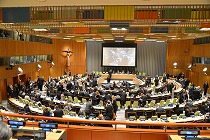 |
| Participants were allowed to attend the actual plenary meetings held every day. The objectives of each country were expressed in matter-of-factly speeches and participants witnessed new developments and subtle drama. During the conference’s “Civil Society Presentations Session”, representatives of the civil society delivered their opinion to the government officials. The Nagasaki Mayor, atomic bombing victims, and the representative for the youth all presented. The youth members worked with other European & American youth NGOs to make a draft for the youth lecture. |
|
| ■ Networking | 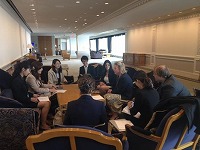 |
| On top of government officials from over a hundred countries and international institution representatives, the Preparatory Committee is a gathering place for people from around the globe who share an interest in nuclear problems. Members of the youth made the most of this opportunity by exchanging ideas with Secretary-General Ban Ki-Moon and other the United Nations officials as well as government diplomats and NGO representatives. Participants also had the opportunity to give presentations and speeches at government sponsored reception and at the Mayors for Peace, among other NGOs hosted side-events of the conference. High school visits were organized with a local New York NGO and atomic bombing victims. A large, additional benefit to the participants was the opportunity they had to meet and interact with many other youths from all around the globe. They surely made connections that will help their future. The participants interviewed many people they met at the conference. The youth members asked, “What do you want to accomplish by 2015 for nuclear disarmament” and videoed the responses so as to share their experience with as many people as possible. |
|
| ■ Teaching Peace at a Japanese School | 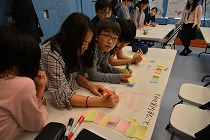 |
| The youth members worked to harness the expertise and experience of each individual, whether it be a specialization in medicine, economics, or education, among others. Participants majoring in education visited the Japanese Children’s Society, a Japanese school in New Jersey, and taught classes on peace. Eighteen fifth and sixth graders took the 85 minute class with the motifs of “What is Peace?” and “What Can We do to Bring Peace to the World?”. It was an opportunity for all the children to think and imagine how they could bring their perception of peace to reality. |
|
| ■ Exchanging Ideas with German University Students | 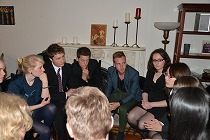 |
| The youth members participated in a session with about thirty university students from the Technische Universität Darmstadt and University of Hamburg to exchange ideas and opinions. The two German universities sent their students to the NPT Conferences as part of their “Simulating Negotiations for the Nuclear Weapons Convention” program. The youth members had been in contact with the German universities in advance. Through mailing lists they agreed on “The Nuclear Umbrella” and “Nuclear Power Plants” as topics and decided to present their nation’s current state of affairs on the matter. Japan and Germany have a lot in common. Breaking up into smaller groups, the discussions became very heated. |
3. Coming Home
| ■ Exchanging Ideas with University Students from the USA On May 15th, we held a session at the Nagasaki Atomic Bomb Museum where youth members exchanged ideas and opinions with students from the University of Indianapolis who visited Nagasaki as part of their “Hiroshima-Nagasaki Peace Study Course”. There was a very fruitful discussion on the differences in peace education and the Japanese youth’s perceptions on nuclear weapons. |
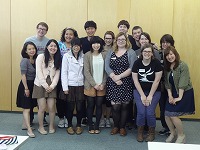 |
| ■ Briefing Session Time to Change the World!— Nagasaki Youth Delegation: Challenges in New York — |
|
| A Briefing Session was held on May 20th at Nagasaki University’s Bunkyo Campus to summarize the activities. In preparing for the brief, the youth members thoroughly discussed how they could best relay to other youths what they learned and thought through their experience. Nuclear weapons are not a problem in the distant or someone else’s problem; rather, the youth wanted to relay that these are issues we should be tackling. In the latter half of the two-part session, attendees were divided into smaller groups and had the opportunity to hold discussions with the youth members. |
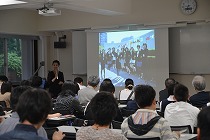 |
*************************************************************************************
Even after wrapping up their official activities as the Second Youth Delegation, the youth members still use the knowledge, experience, and networks they gained, as they remain active in their various ways. There have been more opportunities to inform elementary students and the younger generation about the “Importance of Youth Participation”.
Keeping the next NPT Review Conference and 70th anniversary of the Nagasaki and Hiroshima atomic bombings in sight, there are new activities planned for 2015. With volunteers from the Youth Delegation, there are plans to host a conference in Nagasaki during the summer of 2015 for youth from Japan and abroad to discuss nuclear issues. Leading up to this conference was an event held for the 69th Anniversary of the Nagasaki Atomic Bombing on August 10th where university students acted as international diplomats and held a Model United Nation to simulate negotiations on the disarmament of nuclear weapons. University students from the Technische Universität Darmstadt and other youth that the participants met in New York came to participate in an event titled the “Peace Bridge 2015: Reflecting on the Current State of Nuclear Weapons” and promises for cooperation in 2015 were made.
The following message was included in this year’s Nagasaki Peace Declaration.
“In Nagasaki, young people are thinking about nuclear weapons for themselves, conducting discussions, and initiating new activities. Our university students have begun spreading networks overseas. Our high school students have collected over one million signatures for a petition which they presented to the United Nations calling for the abolition of nuclear weapons.”
It seems as though many university students have the attitude that the concept of “Nuclear Weapons” is “distant, difficult, and not related to their selves”. Although gradually, but surely, there has been a growing number of youth in Nagasaki who have sparked an interest in this issue as a result of the Nagasaki Youth Delegation’s efforts.



